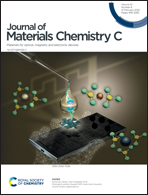Electrochemistry of new generation conformal polyaniline/carbon scaffolds with monodispersed nanopores and high capacitance†
Abstract
The use of composite materials, such as conducting polymer/carbon mixtures, has been shown to be a promising approach for multiple applications, including increasing the electrochemical capacitance for use in supercapacitors and capacitive deionization (CDI). Coating polymers onto nanoporous carbon particles is one option, but achieving this without clogging the internal pores or the pores between particles is a challenge. In this work, a thin, conformal polyaniline (PANI) film was coated for the first time on the internal surface of a family of novel 80 μm thick self-supported nanoporous carbon scaffolds (NCSs) using the potentiodynamic method, controllably giving uniform PANI thicknesses of 3–15 nm. It is shown that PANI deposition does not damage the NCS skeleton structure and results in only a ∼5% decrease in the specific surface area. The electrochemistry is also very promising, with the as-prepared PANI/NCS composites exhibiting a gravimetric capacitance that is 5–20 times that of the original NCS due to the added PANI pseudocapacitance. Furthermore, the rate of charge/discharge is only slightly lowered as a result of the smaller pore sizes, giving only minor ion transport limitations. These findings show that the PANI/NCS composites are very promising for future electrochemical and environmental applications, such as in supercapacitors and CDI devices, potentially when also combined with ultrafiltration.



 Please wait while we load your content...
Please wait while we load your content...